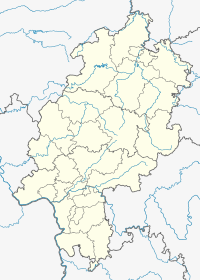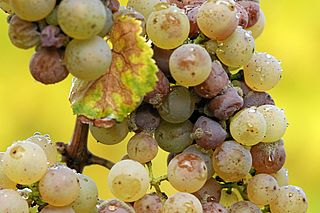
Noble rot is the beneficial form of a grey fungus, Botrytis cinerea, affecting wine grapes. Infestation by Botrytis requires moist conditions. If the weather stays wet, the damaging form, "grey rot", can destroy crops of grapes. Grapes typically become infected with Botrytis when they are ripe. If they are then exposed to drier conditions and become partially raisined, this form of infection is known as noble rot. Grapes picked at a certain point during infestation can produce particularly fine and concentrated sweet wine. Wines produced by this method are known as botrytized wines.

German wine is primarily produced in the west of Germany, along the river Rhine and its tributaries, with the oldest plantations going back to the Roman era. Approximately 60 percent of German wine is produced in the state of Rhineland-Palatinate, where 6 of the 13 regions (Anbaugebiete) for quality wine are situated. Germany has about 103,000 hectares of vineyard, which is around one tenth of the vineyard surface in Spain, France or Italy. The total wine production is usually around 10 million hectoliters annually, corresponding to 1.3 billion bottles, which places Germany as the eighth-largest wine-producing country in the world. White wine accounts for almost two thirds of the total production.

The German wine classification system puts a strong emphasis on standardization and factual completeness, and was first implemented by the German Wine Law of 1971. Nearly all of Germany's vineyards are delineated and registered as one of approximately 2,600 Einzellagen, and the produce from any vineyard can be used to make German wine at any quality level, as long as the must weight of the grapes reaches the designated minimum level. As the current German system does not classify vineyards by quality, the measure of wine ’quality’ is the ripeness of the grapes alone.

Spätlese is a German wine term for a wine from fully ripe grapes, the lightest of the late harvest wines. Spätlese is a riper category than Kabinett in the Prädikatswein category of the German wine classification and is the lowest level of Prädikatswein in Austria, where Kabinett is classified in another way. In both cases, Spätlese is below Auslese in terms of ripeness. The grapes are picked at least seven days after normal harvest, so they are riper and have a higher sugar content. Because of the weather, waiting to pick the grapes later carries a risk of the crop being ruined by rain. However, in warm years and from good sites much of the harvest will reach Spätlese level.
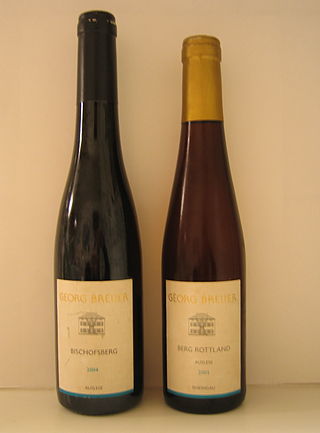
Auslese is a German language wine term for a late harvest wine and is a riper category than Spätlese in the Prädikatswein category of the Austrian and German wine classification. The grapes are picked from selected very ripe bunches in the autumn, and have to be hand-picked. Generally Auslese wine can be made in only the best harvest years that have been sufficiently warm. A small proportion of the grapes may be affected by noble rot in some regions although this never dominates the character of the wine. Rheingau winemaker Schloss Johannisberg is generally credited with discovering Auslese wine in 1787.

The Rheingau is a region on the northern side of the Rhine between the German towns of Wiesbaden and Lorch near Frankfurt, reaching from the Western Taunus to the Rhine. It is situated in the German state of Hesse and is part of the Rheingau-Taunus-Kreis administrative district. It is famous for Rheingau wines, especially the "Rheingauer Riesling," and its many taverns.

Eberbach Abbey is a former Cistercian monastery in Eltville in the Rheingau, Germany. On account of its Romanesque and early Gothic buildings it is considered one of the most significant architectural heritage sites in Hesse.

Geisenheim is a town in the Rheingau-Taunus-Kreis in the Regierungsbezirk of Darmstadt in Hessen, Germany, and is known as Weinstadt, Schulstadt, Domstadt and Lindenstadt.
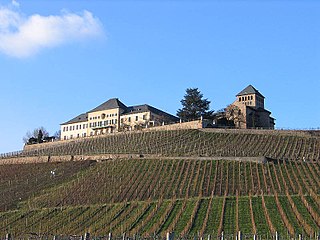
Rheingau is one of 13 designated German wine regions (Weinbaugebiete) producing quality wines . It was named after the traditional region of Rheingau, the wine region is situated in the state of Hesse, where it constitutes part of the Rheingau-Taunus-Kreis administrative district. Although, making up only 3 percent of the total German vineyard area, Rheingau has been the source of many historically important innovations in German wine making, and contains many wine producers of international reputation, such as Schloss Johannisberg. Rheingau, with 3,125 hectares of vineyards in 2016, also boasts a higher proportion of Riesling (77.7%) than any other German wine-growing region, with Spätburgunder making up most of the rest (12.2%), followed by Müller-Thurgau.

Schloss Vollrads is a castle and a wine estate in the Rheingau wine-growing region in Germany. It has been making wine for over 800 years.

The Rheingau Musik Festival (RMF) is an international summer music festival in Germany, founded in 1987. It is mostly for classical music, but includes other genres. Concerts take place at culturally important locations, such as Eberbach Abbey and Schloss Johannisberg, in the wine-growing Rheingau region between Wiesbaden and Lorch.
Andreas Pruys is a German classical bass singer.

Elisabeth Scholl is a German soprano and academic teacher.
Daniel Sans is a German tenor.
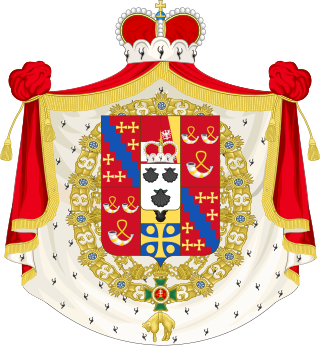
The House of Metternich was an old German noble family originating in the Rhineland. The most prominent member was Prince Klemens von Metternich, who was the dominant figure at the Congress of Vienna (1814–1815). As a former reigning house (mediatised), the Metternich family belonged to the small circle of high nobility.
Princess Tatiana von Metternich-Winneburg was a Russian aristocrat, philanthropist, artist, and patron of the arts. She published her books and watercolours under the name Tatiana von Metternich. She supported charity, especially the Red Cross and the Order of St. Lazarus, which she served as Grand Bailiff for Germany. She was a founding member of the Rheingau Musik Festival, made parts of Schloss Johannisberg available as concert venues for the festival and served as the president of its Kuratorium until her death.
Weingut Dr. Heinrich Nägler is a German wine grower and producer based in Rüdesheim am Rhein, in the wine-growing region of Rheingau, Germany.

Rheingauer Kantorei, now Neue Rheingauer Kantorei, is a mixed choir of the Rheingau region in Germany, performing mostly sacred music in services and concerts.
Paul Alfons Maria Clemens Lothar Philippus Neri Felix Nicomedes Prinz von Metternich-Winneburg was a German-Austrian racing driver and President of the Commission Sportive Internationale (CSI), before becoming President of the Fédération Internationale de l'Automobile (FIA) in 1975.
Schloss Westerhaus is the largest estate in Rheinhessen. It is located on the hill Westerberg (Rheinhessen) near Großwinternheim borough of Ingelheim am Rhein. Today it is a well-known VDP winery and is run by the fourth generation. The vineyards consist of ancient shell limestone rocks and the winery's wine cellar is carved into the mountain, which is reminiscent of a stalactite cave in appearance, but is ideally suited as wine cellar. Weingut Schloss Westerhaus is a member of the Verband Deutscher Prädikatsweingüter (VDP).

